Self-Service Access to AI Workbenches for Your Developers
Provide developers, data scientists, researchers, and all cloud users with self-service access to AI Workbenches using proven templates with guardrails included.

Why AI Workbenches-as-a-Service?
Every modern enterprise is leveraging AI. Enterprises that streamline the process of learning and experimenting with AI by providing self-service for developers and data scientists gain significant benefits.
Speed AI Journey
Empower developers and datascientists to deploy AI environmentsthey need, when they need them.
Reduce Overhead
Reusable AI templates reduce theneed for platform and cloud teams toprovision environments repeatedly.
Simplify Maintenance
Platform teams now update andmaintain configurations via a set ofreusable templates.
Unique Rafay Capabilities for AI Workbenches-as-a-Service
Dozens of enterprise platform teams leverage these unique features to rapidly build AI Workbenches-as-a-service automation with Rafay and delight their developers.
Lifeycle Management
Secure self-service for namespaces
Users should be able to provision namespacesbut should not have access to resourcesoutside of their namespaces
Infrastructure as Code (IaC) support
Support for TF or GitOps first approaches, including private Git repos, that accelerate infrastructure deployment
Resource quotas for teams & applications
Define quotas to prevent noisy neighbor issues so total namespace resource requests do not exceed the configured limits
Management of namespace compliance
Easily manage compliance of pre-existing namespaces in the same manner (i.e. same guardrails) as new namespaces
Integrate with continuous delivery
Work with CD tools like Argo, enforcing guardrails (e.g. quotas, network policies) on namespaces created out of band
Centralized visibility into namespaces
Use cross account and cross cloud visibility to manage complex multi-cloud environments across teams, geos, and domains
Streamlined disaster recovery
Leverage one step workflows to quickly and safely restore data from backups during disaster recovery events
Developer Self-Service
Flexible interfaces
Ability to consume the platform through the preferred interface: UI, Backstage, GitOps or CMDBs (e.g. ServiceNow)
Simple, streamlined process for requesting compute
No time consuming ticket driven process where the Platform team has to manually provision namespaces
Visualization of namespace resources
View into “what resources” are violating policies so that it is easy to remediate and course correct (for future actions)
Streamlined experience for kubectl access
To help with scenarios such as:
Application right sizing exercise
Requesting platform team for additional computer
Repository of approved applications
Integrated, low touch experience for installing applications that have been scanned for vulnerabilities etc.
Governance
Network policies for namespace isolation
Enforce network policies so that namespaces belonging to different teams cannot communicate with each other
Just in Time (JIT) user identity driven access
Implement RBAC at scale with your Identity Provider, without implementing expensive solutions (bastion, VPN, etc.) so users access only their namespaces.
Centralized kubectl access audits
Centralized visibility into user actvities + ability to export audits to an external system (e.g. Splunk, Datadog)
Chargeback and showback
Collect cluster utilization metrics for chargeback / showback models, including sharing costs across tenants for unallocated resources and common services
Identify underutilized namespaces
Collect of Granular utilization metrics from namespaces to show usage by CPU, Memory
Centralized policy enforcement
Enforce policies for security, reliability and operational efficiency, with centralized visibility into policy violations
Compliance benchmarks
Run periodic scans against benchmarks (CIS, NSA hardening recommendations etc.) and centrally aggregate the benchmark reports
Deployment Features
SaaS based
The default option – providing maximum efficiency and reliability for mature and growing customers
Self-hosted
A self-hosted, airgapped option may be necessary for highly regulated industries
Multi-tenant
“Namespace as a service” across multiple teams, with isolation and tight access controls
Unique Rafay Capabilities for AIWorkbenches-as-a-Service
Dozens of enterprise platform teams leverage these unique features to rapidly build AI Workbenches-as-a-service automation with Rafay and delight their developers.
Workbench: KubeFlow with Amazon EKS



RAG: Anthropic Claude on AWS Bedrock



RAG: Cohere on AWS Bedrock



RAG: Llama-2 on AWS



RAG: Mistral on AWS



RAG: Mistral on OCI



Co-Pilot: Wizardcoder on AWS



Co-Pilot: Wizardcoder on OCI



RLHF/DPO: Wizardcoder on AWS



RLHF/DPO: Wizardcoder on OCI



Code Generation: Wizardcoder on AWS



Code Generation: Wizardcoder on OCI



Speech-To-Text: Whisper on AWS



Speech-To-Text: Whisper on OCI



Workbench: Jupyter Notebook with Amazon EKS



Stateless, Springboot (Java) Application Env



Stateless, Django (Python) Application Env



Stateless, NodeJS Application Env



Stateless, GoLang Application Env



Stateful, Springboot (Java) Application Env



NaaS on Upstream Kubernetes



Stateless, Springboot (Java) Application Env



Stateless, Django (Python) Application Env



Stateless, NodeJS Application Env



Stateless, GoLang Application Env



CaaS on Upstream Kubernetes



10 Multi-Tenancy Best Practices for Namespaces as a Service (NaaS)
he white paper guides organizations in leveraging Kubernetes effectively for improved resource utilization and cost efficiency.

Want to Start Now?
See for yourself how Rafay delivers the automation developers and operations want with the right level of standardization, control and governance platform teams need!




















